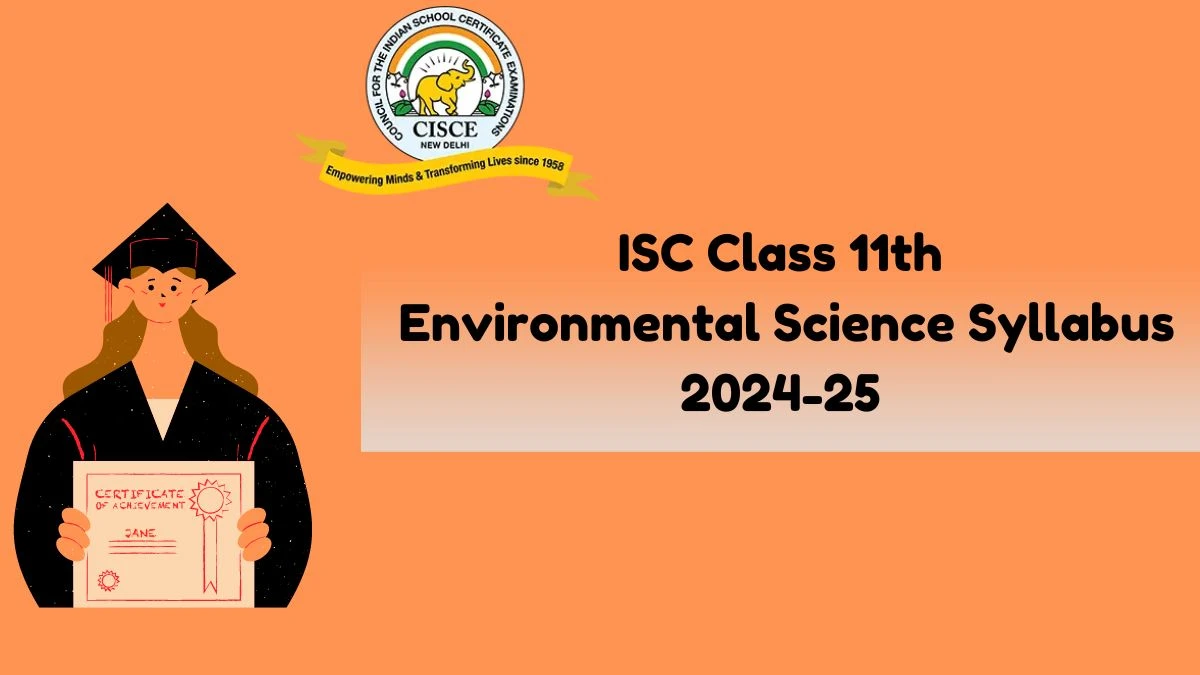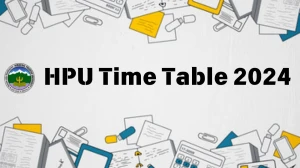- Rojgarlive »
- Education »
- ISC Class 11th Environmental Science Syllabus 2024-25 @ cisceboard.org/ Syllabus Here
ISC Class 11th Environmental Science Syllabus 2024-25 @ cisceboard.org/ Syllabus Here
by Keerthika
Updated May 09, 2024

ISC Class 11th Environmental Science Syllabus 2024-25 @ cisceboard.org
The ICSE Board has released the ISC Class 11 Environmental Science syllabus for the academic year 2024-25. This article provides access to the complete curriculum in PDF format, including details on the syllabus, course structure, and project work. The information is sourced from the official ISC board website, ensuring students can confidently refer to and download the PDF. Candidates are expected to complete two papers, one for theory and the other for project work.
Check - ISC Class 11th Environmental Science Syllabus 2024-25
SC Class 11 Environmental Science Syllabus: Aims
- To help the student appreciate man's place in the natural systems.
- To provide a wide understanding of knowledge resources relevant to environment protection and conservation.
- To provide an in-depth study of certain environment related areas.
- To place environmental concerns in a technological, social, political and economic context.
- To provide a context for understanding the role of individual values in conservation.
- To provide a context for the individual student to reflect on his/her beliefs and values in relation to the environment.
- To provide an opportunity to acquire interdisciplinary skills, knowledge and understanding and to apply this logically and coherently in the field of environmentalconservation.
- To encourage student initiative and resourcefulness in action leading to environmental protection and conservation.
- To present environmental concerns in a challenging way and thereby encourage students to consider careers in the environmental field.
ISC Class 11 Environmental Science Syllabus Key Highlights
There will be two papers in the Environmental Science subject:
|
Paper I: Theory (3 hours) |
70 Marks |
|
Paper II: Practical/Project Work |
30 Marks |
ISC Class 11 Environmental Science Syllabus 2024-25
The Environmental Science curriculum for ISC Class 11 for the year 2024-25 has been officially released by the board. Students can refer to the table below for more understanding regarding the course structure:
PAPER I - THEORY
|
SECTION A |
|
1. Modes of Existence (i) Modes of existence and resource use: hunting gathering; pastoral; agricultural; industrial. Modes of existence and resource use: hunting - gathering; pastoral; agricultural; industrial. Two features defining each mode of existence. (ii) Their impact on natural resource base: energy resources; material resources; scale of catchment; quantity of resources used. Impact of each mode on the available natural resources. (iii)Their ecological impact: land transformation; habitat; diversity; modification of biogeochemical cycles; modification of climate; substantial use. The scale of catchment; quantity of resources used, land transformation; impact on habitat, biodiversity, modification of biogeochemical cycles, modification of climate, substantial use to be taught only to create a better understanding and not for testing (iv) Their social organisation: size of group; kinship; division of labour; access to Resources. Self-explanatory. (v) Their ideology and idiom of man-nature relationship. Self-explanatory. (vi) An appreciation of the coexistence of all four modes of existence in contemporary India. Self-explanatory. (vii) Ecological conflicts arising therein. Self -explanatory. |
|
2. Ecology (i) Concept of an ecosystem: definition; relationships between living organism, e.g. competition, predation, pollination, dispersal, food chains, webs; the environment - physical (soil, topography, climate); biotic - types of relationships (competition, mutualism, parasitism, predation, defence); soil types and vegetation; co-evolution and introduction of species. Definition of ecology and ecosystem. Structure of an ecosystem: biotic and abiotic components. Trophic relationships: food chains and food webs. Biomagnification and bioaccumulation of toxic wastes. Relationships between living organisms: competition, predation, mutualism, parasitism, commensalism. Examples of each Type. Coevolution - Definition and types with examples. (ii) Habitats and niches: Gause's competitive exclusion principle; resource partitioning. Definition and a basic understanding of the above. (iii) Flow of energy: efficiencies - photosynthetic- trophic - assimilation - production; trophic levels; generalised model of the ecosystem; ecological pyramid (numbers and biomass); food webs. An understanding that a small fraction of the sun’s energy is captured by the primary producers and thereafter, at every trophic level, assimilation efficiency reduces. Pyramid of flow of energy. (iv) Nutrient cycles: generalised model; a study of carbon, nitrogen cycles (biological and geological); man's intervention; pollution as disruption of these cycles; ecosystem as a source of material and sink waste for human societies; ecological succession - causes (autogenic and allogenic) - patterns of successions. An understanding of hydrological, carbon, nitrogen and phosphorous cycles showing the linkages between the biotic and abiotic elements (An understanding that different species thrive under different conditions – a basic understanding of the Law of Tolerance). Definition of Ecological succession. Classification as primary and secondary. Causes (autogenic and allogenic). Understanding of the stages of succession. (v) Biomes: terrestrial; fresh water; marine; a survey of the biomes of India and their inhabitants. Examples of Biomes - Tropical rain forests, deserts, grasslands, coral reefs, lakes. Any five biomes to be explained with reference to climate, topography, flora, fauna and their adaptations. |
|
3. Pollution (i) Disruption of nutrient cycles and habitats: atmospheric pollution; human activities that change the composition of the atmosphere; connection between pollution and development; local and global effects (greenhouse effect, ozone depletion) and their impact on human life; burning of fossil fuel products - effect on ecosystem and human health. (ii) Pollution control approaches - prevention and control: as applied to fossil fuel burning; the role of PCBs; industrial pollution control - principles - devices - costs - policy incentives; combating global warming; the international political dimensions; third world interest; impact on economic growth. (iii)Water pollution: water cycle; pollution of surface water, ground water, ocean water; industrial pollution and its effects; domestic sewage and its treatment - techniques and appropriate technology; marine ecosystem protection and coastal zone management; soil pollution - sources - effects. |
|
SECTION B |
|
4. Legal Regimes for Sustainable Development (i) National legislative frameworks for environment protection and conservation; survey of constitutional provisions (including directive principles); national laws; state laws in India. (ii) International legal regimes: on trade and environment (GATT, WTO, IPR, TNC's, regional arrangements and preferential trade arrangements); on climate; on common resources (forests, bio-diversities, oceans and space); international institutions (UNEP, UNCTAD, WHO, UNDP, etc.); international initiatives (Earth Summit, Agenda 21). |
|
5. Technology and Environment (i) Technological evolution and models: hi-tech; low-tech; intermediate; appropriate; traditional; interaction between technology, resources, environment and development; energy as a binding factor; the need for reorienting technology. (ii) Renewable energy: limitations of conventional sources; sources of renewable energy and their features (solar, wind, biomass, micro-hydel and muscle power). (iii) Health: incidents of disease as an indicator of the health of the environment; prevention of diseases by better nutrition, sanitation, access to clean water, etc.; communicable and noncommunicable diseases; techniques of low cost sanitation; policy and organisation to provide access to basic health service for all; the role of traditional and local systems of medicine. (iv) Biotechnology: potential; limitations. |
|
SECTION C |
|
6. Design and Planning for Environmental Conservation and Protection (i) Ecosystem analysis: understanding complex systems; critical and state variables as system indicators; indicators of inter-relationships; successions and systems resilience; predicting and assessing system responses to impacts and their interventions; rapid appraisal methods. (ii) Human environment interactions: quantity of life vs. quality of environment; environmental issues and problems; role of belief and values; analysing brief statements for underlying values; issues analysis - separating symptoms from problems; problem identification; identifying the players and their positions; understanding interacting problems and identifying critical control points; problems analysis; identifying variables (human behaviours, values, ecological, etc.); determining the relationships between variables; formulating questions for research; planning research; generating problems, solution, briefs and specifications. (iii)Evaluation and assessment of impacts: approaches and techniques of environment and social impact assessment; environment impact assessment as a planning tool and a decision making instrument; interpreting environment impact assessments. (iv) Design of solutions: generating solution options; overcoming blocks in thinking; generative and lateral thinking; using criteria (social, political, ecological, technological, economic) to rank and prioritise solution ideas; check solutions for economic, social and technical viability; collation of solution into coherent plans; planning sequence and cost. |
ISC Class 11th Environmental Science Syllabus 2024-25? -FAQ
The subjects of examination include English as a compulsory subject and a list of elective subjects. The list of electives contains subjects like Geography, Sociology, History, Physics, Biology, Chemistry, Home Science, etc.
The syllabus of ISC mentions all the topics and chapters to be covered while preparing for the exams. This year, the Council has decided to go back to its earlier norm of conducting the board exams annually, i.e, once at the end of the academic session. The Council has also revised the ISC 2024 syllabus in select subjects. Students can click on the link provided to download it.




